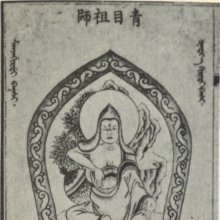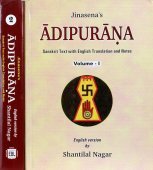Candrakirti, Candrakīrti: 8 definitions
Introduction:
Candrakirti means something in Buddhism, Pali, Hinduism, Sanskrit, Jainism, Prakrit. If you want to know the exact meaning, history, etymology or English translation of this term then check out the descriptions on this page. Add your comment or reference to a book if you want to contribute to this summary article.
Alternative spellings of this word include Chandrakirti.
Images (photo gallery)
In Hinduism
Vyakarana (Sanskrit grammar)
Source: Wikisource: A dictionary of Sanskrit grammarCandrakīrti (चन्द्रकीर्ति).—A Jain grammarian of the twelfth century A.D. who has written a commentary named Subodhini on the Sarasvata Vyakaraha.

Vyakarana (व्याकरण, vyākaraṇa) refers to Sanskrit grammar and represents one of the six additional sciences (vedanga) to be studied along with the Vedas. Vyakarana concerns itself with the rules of Sanskrit grammar and linguistic analysis in order to establish the correct context of words and sentences.
Ayurveda (science of life)
Veterinary Medicine (The study and treatment of Animals)
Source: Shodhganga: Portrayal of Animal Kingdom (Tiryaks) in Epics An Analytical studyCandrakīrti (चन्द्रकीर्ति) (lit. “one who has the eyes on feathers”) is a synonym (another name) for the Peacock (Mayūra), according to scientific texts such as the Mṛgapakṣiśāstra (Mriga-pakshi-shastra) or “the ancient Indian science of animals and birds” by Hamsadeva, containing the varieties and descriptions of the animals and birds seen in the Sanskrit Epics such as the Ramayana and Mahabharata.

Āyurveda (आयुर्वेद, ayurveda) is a branch of Indian science dealing with medicine, herbalism, taxology, anatomy, surgery, alchemy and related topics. Traditional practice of Āyurveda in ancient India dates back to at least the first millenium BC. Literature is commonly written in Sanskrit using various poetic metres.
In Buddhism
Tibetan Buddhism (Vajrayana or tantric Buddhism)
Source: Google Books: Mahāmudrā and Related InstructionsCandrakīrti (चन्द्रकीर्ति) is the name of an ancient teacher belonging to the “lineage of the profound view”, according to “the succession of Gurus in the Mahāmudrā lineages” in the Kagyü School of Tibetan Buddhism (the Mahāmudrā deals with the nature of the mind).—The graduated path of the three levels of beings, which is an adornment [for the Mahāmudrā], is of three lineages: 1. The lineage of vast conduct; 2. The lineage of the profound view; 3. The lineage of the blessing of practice.—[The lineage of vast conduct]—(1) The perfect Buddha,... (5) Candrakīrti,... and (8) Atiśa.

Tibetan Buddhism includes schools such as Nyingma, Kadampa, Kagyu and Gelug. Their primary canon of literature is divided in two broad categories: The Kangyur, which consists of Buddha’s words, and the Tengyur, which includes commentaries from various sources. Esotericism and tantra techniques (vajrayāna) are collected indepently.
General definition (in Buddhism)
Source: academia.edu: The Chronological History of BuddhismCandrakirti (880-800 BCE) or Chandrakirti, a South Indian, was a Buddhist scholar of Nalanda. He was the disciple of Aryadeva II and not Aryadeva I. He founded a new school of Madhyamika philosophy known as Prasangika Madhyamika. He debated with Chandragomin at Nalanda for years. Chandrakirti defended Buddhapalita against Bhavaviveka. Chandrakirti also wrote a treatise on grammar known as “Samantabhadra-Vyakarana”.
In Jainism
General definition (in Jainism)
Source: archive.org: Trisastisalakapurusacaritra1) Candrakīrti (चन्द्रकीर्ति) is the wife of king Dīptacūla from Kinnaragīta, according to chapter 5.3 [śāntinātha-caritra] of Hemacandra’s 11th century Triṣaṣṭiśalākāpuruṣacaritra: an ancient Sanskrit epic poem narrating the history and legends of sixty-three illustrious persons in Jainism.
Accordingly, as the Vidyādhara Pavanavega said to king Vajrāyudha:—“[...] There is a mountain Vaitāḍhya in the province Sukaccha, the ornament of Videhakṣetra in this same Jambūdvīpa. [...] On the same Vaitāḍhya lived King Dīptacūla in the city Kinnaragīta, the ornament of the north row. His wife Candrakīrti bore a daughter, Sukāntā, with all the auspicious marks, whom I married. [...]”.
2) Candrakīrti (चन्द्रकीर्ति) is the name of an ancient king from Campā, according to chapter 6.7 [śrī-munisuvratanātha-caritra].—Accordingly:—“ [...] Thus resolving, the god [i.e., Vīra incarnated in Saudharma] took them [i.e., Hari and Hariṇī] both with wishing-trees to the city Campā in this Bharata. Just then the king in this city, Candrakīrti, belonging to the Ikṣvāku family, had died without a son. Then the ministers began to search on all sides for a man suitable to be king, like yogis searching for the soul. [...]”.

Jainism is an Indian religion of Dharma whose doctrine revolves around harmlessness (ahimsa) towards every living being. The two major branches (Digambara and Svetambara) of Jainism stimulate self-control (or, shramana, ‘self-reliance’) and spiritual development through a path of peace for the soul to progess to the ultimate goal.
Languages of India and abroad
Sanskrit dictionary
Source: Cologne Digital Sanskrit Dictionaries: Monier-Williams Sanskrit-English Dictionary1) Candrakīrti (चन्द्रकीर्ति):—[=candra-kīrti] [from candra > cand] m. Name of a prince of Ujjayinī, [Bhadrabāhu-caritra]
2) [v.s. ...] of a Sūri of the Jainas.
[Sanskrit to German]
Sanskrit, also spelled संस्कृतम् (saṃskṛtam), is an ancient language of India commonly seen as the grandmother of the Indo-European language family (even English!). Closely allied with Prakrit and Pali, Sanskrit is more exhaustive in both grammar and terms and has the most extensive collection of literature in the world, greatly surpassing its sister-languages Greek and Latin.
See also (Relevant definitions)
Partial matches: Candra, Kirti.
Starts with: Candrakirti suri.
Query error!
Full-text (+18): Candrakirti suri, Prasannapada, Kirtibuddhivilasini, Subodhika, Chandahkosha, Vidyakokila, Vidyakaukila, Subodhini, rigs pa'i khu byug, Loka, Sukanta, Aloka, Prakritachandahkosha, Lokasamvriti, Alokasamvriti, Harshakirti, Taimirika, Madhyamakavatara, Akashapushpa, Prasangikamadhyamaka.
Relevant text
Search found 24 books and stories containing Candrakirti, Candra-kirti, Candra-kīrti, Candrakīrti; (plurals include: Candrakirtis, kirtis, kīrtis, Candrakīrtis). You can also click to the full overview containing English textual excerpts. Below are direct links for the most relevant articles:
Blue Annals (deb-ther sngon-po) (by George N. Roerich)
Chapter 2 - Spa tshab together with his lineage < [Book 6 - The Origin of the Mādhyamika (middle way)]
Chapter 5a - Minor lineages (brgyud phran gyi skabs) < [Book 12 - Peace-Making Lineages]
Chapter 16 - Shes rab rgyal mtshan < [Book 10 - The Kālacakra]
Karandavyuha Sutra (by Mithun Howladar)
Part 16 - Brief Analysis of Three Mahāyāna Buddhists < [Appendix 2 - Buddhist Philosophy]
Part 19 - Conclusion < [Appendix 2 - Buddhist Philosophy]
Part 18 - Perspective on Bodhisattva and Śrāvaka < [Appendix 2 - Buddhist Philosophy]
Bodhisattvacharyavatara (by Andreas Kretschmar)
Text Section 186 < [Khenpo Chöga’s Oral Explanations]
Text Section 40 < [Khenpo Chöga’s Oral Explanations]
Text Sections 302-306 / Stanza 36 < [Khenpo Chöga’s Oral Explanations]
Yasastilaka and Indian culture (Study) (by Krishna Kanta Jandiqui)
2. Discussion of Buddhist doctrines < [Chapter 8 - Philosophical doctrines]
6. The Barhaspatya school of thought < [Chapter 9 - Schools of Thought]
Candrakirti's Pancaskandhaprakarana. I. Tibetan text < [Volume 40 (1979)]
M. Siderits and S. Katsura (eds.). Nāgārjuna’s Middle Way. Mūlamadhyamakakārikā. < [Volume 76 (2015)]
Notices of Sanskrit Manuscripts (by Rajendralala Mitra)
Page 392 < [Volume 12 (1898)]
Related products

